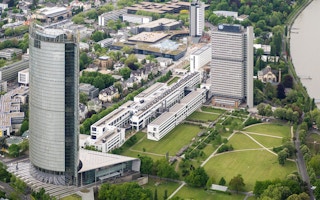Two years after the world joined together to forge the Paris Agreement on climate change, representatives from around the globe will convene in Bonn, Germany, on November 6 for the next round of United Nations talks. The summit marks a critical stepping stone for global climate action.
This year’s wave of climate-related natural disasters—hurricanes, floods and wildfires in developed and developing countries alike—drives home the urgency to move full speed ahead at the 23rd Conference of Parties to the UN Framework Convention on Climate Change, known informally as COP 23.
Increasing public and private investment in the transition to clean energy and transport, in restoring forested areas, and in more sustainable cities demonstrate that significant inroads towards tackling climate change are being made at the national and local level. Countries are also reaffirming their commitment to climate action as a priority—both at home and internationally—including support for the Paris Agreement demonstrated at the G7and G20 summits and at the African Ministerial Conference on the Environment (AMCEN).
Steady progress, however, is not enough. Global greenhouse gas emissions need to start coming down quickly, peaking by 2020 and getting to net-zero by 2050, in order to meet the Paris goal of keeping global temperature rise to well below 2 degrees C (3.6 degrees F) and optimally 1.5 degrees C (2.7 degrees F) above pre-industrial levels. That means there is a small window of opportunity left to make the low-carbon transition in ways that are economically and technically manageable given the options we have today.
COP 23 must continue to strengthen an international climate regime that sends the right market signals, reaffirms support for more ambitious and transformational implementation, raises awareness of the growing impacts of climate change, and mobilises an ever greater number of players to act now before it is too late to avoid the most severe consequences of a changing climate.
Here are four signs to look for at COP 23:
1. Tangible and constructive progress on making the Paris Agreement operational
The implementation guidelines of the Agreement, sometimes referred to as the rulebook, will put the accord fully into motion when finalised at next year’s climate summit in Poland. At Bonn, negotiators need to identify key decision points and the options for resolving them, along with an effective process for crafting clear rules and procedures on a wide range of issues. These include the transparency framework, which includes reporting and review requirements under the Agreement, as well as the ambition mechanism to assess progress and ramp up action every five years.
2. A strong foundation for 2018, the first moment under the Paris Agreement for countries to assess progress and signal their readiness to enhance action
Enhancing climate action every five years, informed by periodically taking stock of progress and identifying new opportunities for action, is a fundamental premise of the Paris Agreement. COP 23 will set in motion the first of these stocktaking exercises next year during the 2018 facilitative dialogue—now called the Talanoa Dialogue. The dialogue will assess global progress towards meeting the Paris long-term goals, highlight opportunities to step up action, and help spur countries to move forward on enhancing their nationally determined contributions (NDCs) by 2020.
In addition, events next year such as the Global Climate Action Summit in September 2018, a gathering of states, cities, businesses and others, will also recognise the decisive role that these actors play and encourage even greater action. Other upcoming initiatives like the December climate finance summit organised by French President Emmanuel Macron will contribute to launching 2018 as a year of pivotal change, with a new momentum to put us on track to driving the investment and action needed to achieve a climate-resilient future.
“
There is a small window of opportunity left to make the low-carbon transition in ways that are economically and technically manageable given the options we have today.
3. Heightened attention to climate impacts and vulnerability, and concrete, practical steps to help vulnerable countries and communities
As the first small island nation to preside over a global climate summit, the government of Fiji has made protecting the vulnerable a strong focus. Negotiators must agree on how to recognise efforts by developing countries to adapt to increasing climate impacts, evaluate effectiveness and mobilise greater support. That includes finance, as well as technology and capacity building.
An important step at COP 23 would be to formally link the Adaptation Fund, which has focused on building community-level resilience, to the Paris Agreement. Negotiators also need to provide guidance on how to increase the share of adaptation finance as developed countries scale up finance to meet their commitment to mobilise $100 billion a year by 2020. Parties must also do more to address loss and damage from climate impacts, even as they recognise the need to curb greenhouse gas emissions and adapt to climate change.
4. A growing wave of support from non-state actors such as cities, businesses and others
Stakeholders outside the negotiations have emerged as critical partners in the fight against climate change. At COP 23, look for businesses, states, cities and others around the world to demonstrate how they are intensifying their efforts, rallying around the Paris Agreement and contributing to national climate goals.
The overwhelming support for climate action from within the United States—despite the Trump administration’s efforts to the contrary—is a prime example. States, cities and companies that make up more than half the US economy have declared support for the Paris Agreement. Rather than back away, they are stepping up, and together they have the potential to significantly move US climate action forward.
At climate negotiations last year in Morocco, we witnessed the world’s steely determination to advance climate action despite any obstacles that may arise. COP 23 is a time to carry that spirit forward and make concrete progress on structuring the Paris Agreement. Moreover, it is an opportunity to set the stage for 2018, when countries can step up their response to the climate challenge and bequeath a livable world for future generations.
Paula Caballero is Global Director, Climate Program of the World Resources Institute, David Waskow is the Director of WRI’s International Climate Initiative, and Christina Chan is the Director for the Climate Resilience Practice. This post is republished from the WRI blog.









